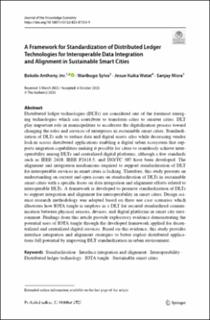| dc.contributor.author | Bokolo, Anthony Junior | |
| dc.contributor.author | Waribugo, Sylva | |
| dc.contributor.author | Watat, Josue Kuika | |
| dc.contributor.author | Misra, Sanjay | |
| dc.date.accessioned | 2023-11-02T12:10:53Z | |
| dc.date.available | 2023-11-02T12:10:53Z | |
| dc.date.created | 2023-10-31T19:05:13Z | |
| dc.date.issued | 2023 | |
| dc.identifier.citation | Journal of the Knowledge Economy. 2023. | en_US |
| dc.identifier.issn | 1868-7865 | |
| dc.identifier.uri | https://hdl.handle.net/11250/3100273 | |
| dc.description.abstract | Distributed ledger technologies (DLTs) are considered one of the foremost emerging technologies which can contribute to transform cities to smarter cities. DLT play important role in municipalities to accelerate the digitalization process toward changing the roles and services of enterprises in sustainable smart cities. Standardization of DLTs aids to reduce data and digital assets silos while decreasing vendor lock-in across distributed applications enabling a digital urban ecosystem that supports migration capabilities making it possible for cities to seamlessly achieve interoperability among DLTs and centralized digital platforms, although a few standards such as IEEE 2418, IEEE P2418.5, and ISO/TC 307 have been developed. The alignment and integration mechanisms required to support standardization of DLT for interoperable services in smart cities is lacking. Therefore, this study presents an understanding on current and open issues on standardization of DLTs in sustainable smart cities with a specific focus on data integration and alignment efforts related to interoperable DLTs. A framework is developed to promote standardization of DLTs to support integration and alignment for interoperability in smart cities. Design science research methodology was adopted based on three use case scenarios which illustrates how IOTA tangle is employs as a DLT for secured standardized communication between physical sensors, devices, and digital platforms in smart city environment. Findings from this article provide exploratory evidence demonstrating the potential uses of IOTA tangle through the developed framework applied for decentralized and centralized digital services. Based on this evidence, this study provides interface integration and alignment strategies to better exploit distributed applications full potential by improving DLT standardization in urban environment. | en_US |
| dc.language.iso | eng | en_US |
| dc.publisher | Springer Nature | en_US |
| dc.rights | Navngivelse 4.0 Internasjonal | * |
| dc.rights.uri | http://creativecommons.org/licenses/by/4.0/deed.no | * |
| dc.subject | standardization | en_US |
| dc.subject | interface integration and alignment | en_US |
| dc.subject | interoperability | en_US |
| dc.subject | distributed ledger technology | en_US |
| dc.subject | IOTA tangle | en_US |
| dc.subject | sustainable smart cities | en_US |
| dc.title | A Framework for Standardization of Distributed Ledger Technologies for Interoperable Data Integration and Alignment in Sustainable Smart Cities | en_US |
| dc.type | Peer reviewed | en_US |
| dc.type | Journal article | en_US |
| dc.description.version | publishedVersion | en_US |
| dc.rights.holder | © The Author(s) 2023 | en_US |
| dc.subject.nsi | VDP::Teknologi: 500 | en_US |
| dc.source.journal | Journal of the Knowledge Economy | en_US |
| dc.identifier.doi | 10.1007/s13132-023-01554-9 | |
| dc.identifier.cristin | 2190737 | |
| cristin.ispublished | true | |
| cristin.fulltext | original | |
| cristin.qualitycode | 1 | |

